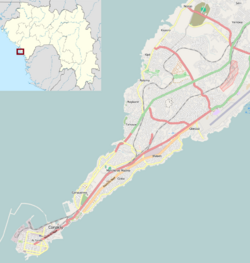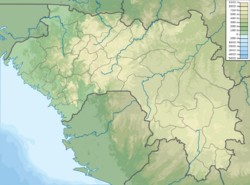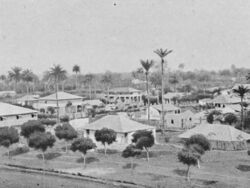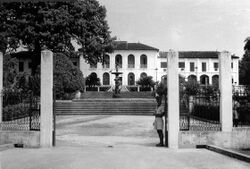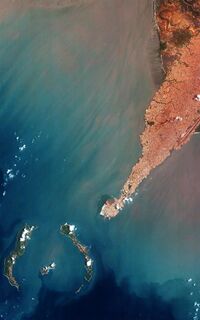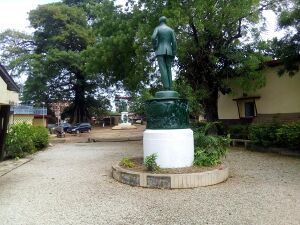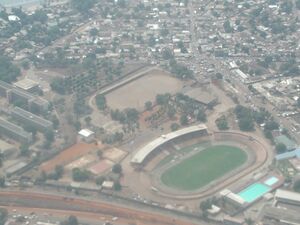Conakry
Topic: Place
 From HandWiki - Reading time: 9 min
From HandWiki - Reading time: 9 min
Conakry | |
|---|---|
Capital city | |
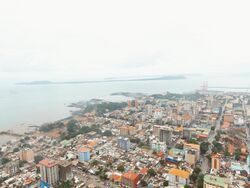 Skyline of Conakry | |
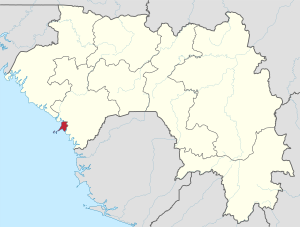 Conakry Region in Guinea | |
Map showing the location of Central Conakry on Tombo Island, with the growing city spreading up the Kaloum Peninsula. | |
| Coordinates: [ ⚑ ] : 09°30′33″N 13°42′44″W / 9.50917°N 13.71222°W | |
| Country | |
| Region | Conakry Region |
| Government | |
| • Governor | M'Mahawa Sylla |
| Area | |
| • Total | 450 km2 (170 sq mi) |
| Population (2014)[1] | |
| • Total | 1,660,973 |
| • Density | 3,700/km2 (9,600/sq mi) |
| Demonym(s) | Conakryka[2] |
| Time zone | UTC±0 (UTC) |
| • Summer (DST) | not observed |
| HDI (2019) | 0.675[3] medium |
Conakry (/ˈkɒnəkri/; French pronunciation: [kɔnakʁi]; Susu: Kɔnakiri; Template:Lang-nqo, Fula: 𞤑𞤮𞤲𞤢𞥄𞤳𞤭𞤪𞤭, romanized: Konaakiri) is the capital and largest city of Guinea. A port city, it serves as the economic, financial and cultural centre of Guinea. Its population as of the 2014 Guinea census was 1,660,973.[4]
The current population of Conakry is difficult to ascertain, although the U.S. Department of State's Bureau of African Affairs has estimated it at two million, accounting for one-sixth of the entire population of the country.[5]
History
Conakry was originally settled on the small Tombo Island and later spread to the neighboring Kaloum Peninsula, a 36-kilometer-long (22 mi) stretch of land 0.2 to 6 kilometers (1⁄8 to 3 3⁄4 mi) wide. The city was essentially founded after Britain ceded the island to France in 1887.[6] In 1885 the two island villages of Conakry and Boubinet had fewer than 500 inhabitants. Conakry became the capital of French Guinea in 1904 and prospered as an export port, particularly after a railway (now closed) to Kankan opened up the interior of the country for the large-scale export of groundnut.
In the decades after independence, the population of Conakry boomed, from 50,000 inhabitants in 1958 to 600,000 in 1980, to over two million today.[7] Its small land area and relative isolation from the mainland, while an advantage to its colonial founders, has created an infrastructural burden since independence.[8]
In 1970, conflict between Portuguese forces and the belligerent PAIGC independence campaigners in neighbouring Portuguese Guinea (now Guinea-Bissau) spilled into the Republic of Guinea when a group of 350 Portuguese troops and Guinean loyalists landed near Conakry, attacked the city and freed 26 Portuguese prisoners of war held by the PAIGC before retreating, having failed to overthrow the government or kill the PAIGC leadership.[9]
Camp Boiro, a feared concentration camp during the rule of Sekou Toure, was located in Conakry.[10]
According to human rights groups, 157 people died during the 2009 Guinea protest when the military junta opened fire against tens of thousands of protesters in the city on 28 September 2009.[11]
Geography
Originally situated on Tombo Island, one of the Îles de Los, it has since spread up the neighboring Kaloum Peninsula.
Climate
According to Köppen climate classification, Conakry features a tropical monsoon climate (Köppen climate classification: Am). Conakry features a wet season and a dry season. Like most of West Africa, Conakry's dry season is dominated by the harmattan wind between December and April. As a result, almost no rain falls in the city during these months.
Compared to most of West Africa, Conakry's wet season sees an extraordinary amount of rainfall, averaging more than 1,100 millimetres (43 in) in both July and August. As a result, Conakry's average annual rainfall totals nearly 3,800 millimetres (150 in). However, the dry season is still dry, with January and February only receiving 1 millimetre (0 in) of rainfall on average. Sunshine is lower in the wet season than the dry season, with August receiving the least sunshine and March receiving the most.
Script error: No such module "weather box".
Population
| Historical population | ||
|---|---|---|
| Year | Pop. | ±% |
| 1958 | 78,388 | — |
| 1983 | 710,372 | +806.2% |
| 1996 | 1,092,631 | +53.8% |
| 2014 | 1,660,973 | +52.0% |
| source:[14] | ||
Government and administration
Conakry is a special city with a single region and prefecture government. The local government of the city was decentralized in 1991 between five municipal communes headed by a mayor.[15] From the tip in the southwest, these are:
- Kaloum – the city centre
- Dixinn – including the University of Conakry and many embassies
- Ratoma – known for its nightlife
- Matam
- Matoto – home to Conakry International Airport.
The five urban communes make up the Conakry Region, one of the eight Regions of Guinea, which is headed by a governor. At the second-tier prefecture level, the city is designated as the Conakry Special Zone, though the prefecture and regional government are one and the same. At an estimated two million inhabitants, it is far and away the largest city in Guinea, making up almost a quarter of the nation's population and making it more than four times bigger than its nearest rival, Kankan.
Economy
Conakry is Guinea's largest city and its administrative, communications, and economic centre. The city's economy revolves largely around the port, which has modern facilities for handling and storing cargo, through which alumina and bananas are shipped. Manufactures include food products and cement, metal manufactures, and fuel products.[16]
Markets
Infrastructure crisis
Periodic power and water cuts have been a daily burden for Conakry's residents since early 2002. Government and power company officials blame the drought of February 2001 for a failure of the hydro-electric supply to the capital, and a failure of aging machinery for the continuation of the crisis. Critics of the government cite mismanagement, corruption and the withdrawal of the power agency's French partner at the beginning of 2002. (As of 2007), much of the city has no traffic lighting in the overnight hours.[18]
Popular anger at shortages in Conakry was entwined with anti-government protests, strikes, and violence against the rule of President Lansana Conté and the successive prime ministers Cellou Dalein Diallo and Eugène Camara appointed to fill the post after the resignation of Prime Minister François Lonseny Fall in April 2004. Violence reached a peak in January–February 2007 in a general strike, which saw over one hundred deaths when the Army confronted protesters.[19]
Transportation
Conakry is serviced by Conakry International Airport which has flights to several cities in West Africa and Europe.
Architecture
Hospitals
Culture
- Sandervalia National Museum[25]
- National Library of Guinea and National Archives of Guinea[25]
- Camp Boiro[26]
- Monument du 22 Novembre 1970[27]
Places of worship
Islamic mosques in the city include the Grand Mosque of Conakry. There are also Christian churches and temples, including the Roman Catholic Archdiocese of Conakry's Cathédrale Sainte-Marie, the Église Protestante Évangélique de Guinée (Alliance World Fellowship), and the Assemblies of God.[28][29]
Universities and education
- Collège Gbessia Centre
- Collège-Lycée Sainte-Marie
- Gamal Abdel Nasser University (Institut Polytechnique de Conakry)[30][31]
- Institut Géographique National (Guinea)[32]
- Université Kofi Annan[33]
Parks and gardens
Notable people
- Mamadi Diakite, NBA basketball player for the Cleveland Cavaliers
- Maciré Sylla, singer, dancer, author and composer
- M'Mahawa Sylla is a Guinean army officer.
See also
- 2007 Guinean general strike
- 2009 Guinea protest
- Île Tamara Lighthouse
References
- Dave, Nomi (2019) The Revolution's Echoes: Music, Politics & Pleasure in Guinea. Chicago: The University of Chicago Press.
- Thomas O'Toole, Janice E. Baker. (2005) Historical Dictionary of Guinea. Scarecrow Press. ISBN:0-8108-4634-9
- Philipps, Joschka (2013) Ambivalent Rage: Youth Gangs and Urban Protest in Conakry, Guinea. Harmattan Guinée.
- Cohen, Adrienne ( 2019) "Performing Excess: Urban Ceremony and the Semiotics of Precarity in Guinea-Conakry." Africa: The Journal of the International African Institute. 89 (4): 718–738.
- Odile Goerg. "Chieftainships between Past and Present: From City to Suburb and Back in Colonial Conakry, 1890s–1950s". Africa Today, Summer 2006, Vol. 52, No. 4, Pages 2–27
- Conakry the Capital: history of the city at site of expat artist.
- HISTOIRE DE CONAKRY, 1463 to present, by Luc MOGENET, reprinted at guineeconakry.info (no date)
- Kids in Guinea Study Under Airport Lamps, RUKMINI CALLIMACHI The Associated Press, Thursday, 19 July 2007.
- Archdiocese of Conakry: history and structure (at catholic-hierarchy.org)
- Guinea's Telecommunication Infrastructure, United Nations Economic Commission for Africa (UNECA), 1999 figures.
Notes
- ↑ "Etat et Structure de la Population Recensement General de la Population et de l'habitation 2014". http://www.stat-guinee.org/images/Publications/INS/RGPH3/RGPH3_etat_structure.pdf.
- ↑ du ministère des affaires étrangères (in French)
- ↑ "Sub-national HDI – Area Database – Global Data Lab" (in en). https://hdi.globaldatalab.org/areadata/shdi/.
- ↑ "GeoHive – Guinea population statistics". geohive.com. http://www.geohive.com/cntry/guinea.aspx.
- ↑ "Background Note: Guinea" . Bureau of African Affairs, U.S. Department of State, January 2007. Retrieved 24 February 2007; World Gazetteer [|permanent dead link|dead link}}]. Retrieved 16 June 2008
- ↑ Roman Adrian Cybriwsky, Capital Cities around the World: An Encyclopedia of Geography, History, and Culture, ABC-CLIO, USA, 2013, p. 89
- ↑ Patrick Manning. Francophone Sub-Saharan Africa, 1880–1995, Cambridge (1998)
- ↑ For the urban infrastructure and its history, see M. Dian DIALLO. Street Addressing And Basic Services in Conakry, Guinea . Presented at the Urban Forum/ World Bank – Washington, D.C. – 2–4 April 2002.
- ↑ "Cloudy Days in Conakry". Time. 7 December 1970. http://www.time.com/time/magazine/article/0,9171,877145,00.html.
- ↑ Gomez, Alsény René (2010). La Guinée peut-elle être changée?. Editions L'Harmattan. ISBN 978-2-296-11963-5.
- ↑ "Guinea massacre toll put at 157". BBC News. 29 September 2009. http://news.bbc.co.uk/2/hi/8280603.stm.
- ↑ "World Meteorological Organization Climate Normals for 1991-2020 — Conakry". National Oceanic and Atmospheric Administration. https://www.nodc.noaa.gov/archive/arc0216/0253808/2.2/data/0-data/Region-1-WMO-Normals-9120/Guinea/CSV/CONAKRY_61832.csv.
- ↑ "Conakry Climate Normals 1961–1990". National Oceanic and Atmospheric Administration. ftp://ftp.atdd.noaa.gov/pub/GCOS/WMO-Normals/TABLES/REG__I/GW/61832.TXT.
- ↑ "Conakry population statistics". http://www.citypopulation.de/en/guinea/cities/.
- ↑ "Guineeconakry.info – Conakry (la capitale)". http://www.guineeconakry.info/index.php?id=85.
- ↑ www.semantico.com. "Europa World Online : Log In" (in en). http://www.europaworld.com/entry/gn.ec.
- ↑ 17.0 17.1 Hudgens, Jim; Trillo, Richard (30 December 2003). The rough guide to West Africa. Rough Guides. p. 558. ISBN 978-1-84353-118-0. https://archive.org/details/roughguidetowest0000hudg. Retrieved 16 March 2011.
- ↑ Conakry's dark streets turning orange. James Copnall, BBC News , Guinea . 23 November 2006.
- ↑ For the relations between the 2007 crisis and infrastructure in Conakry, see:
- Q&A: Guinea emergency , BBC World Service. 13 February 2007.
- Youths Chase Staff From State Electricity Offices, Protesting Power Cuts , 25 October 2007 (UN Integrated Regional Information Networks/All Africa Global Media via COMTEX).
- IRIN In-Depth, Guinea: Living on the edge . UN Office for the Coordination of Humanitarian Affairs, January 2005.
- GUINEA: Power cuts stop for football , 26 January 2006 (IRIN)
- Guinea protests over power-cuts , Alhassan Sillah: BBC, Conakry, 31 January 2003
- Conflict history: Guinea . International Crisis Group, updated 11 May 2007.
- ↑ Schwarz-Bart, Simone; Schwarz-Bart, André (2003). In Praise of Black Women: Modern African women. Univ of Wisconsin Press. p. 121. ISBN 978-0-299-17270-1. https://books.google.com/books?id=HD7U2a1Sp-0C&pg=PA252. Retrieved 16 March 2011.
- ↑ Davidson, Basil (1989). The fortunate isles: a study in African transformation. Africa World Press. p. 104. ISBN 978-0-86543-122-5. https://archive.org/details/fortunateislesst0000davi. Retrieved 16 March 2011.
- ↑ GUINEA Dying for Change Brutality and Repression by Guinean Security Forces in Response to a Nationwide Strike. Human Rights Watch. 2007. p. 17. GGKEY:1UZAQCJ7E3A. https://books.google.com/books?id=nUmNSsrjqsYC&pg=PA17. Retrieved 16 March 2011.
- ↑ Rev Fr Gynecol Obstet, Diallo MS, Diallo TS, Diallo FB, Diallo Y, Camara AY, Onivogui G, Keita N, Diawo SA. (1995) Mar;90(3):138-41., Anemia and pregnancy. Epidemiologic, clinical and prognostic study at the university clinic of the Ignace Deen Hospital, Conakry (Guinee) , Clinique universitaire de Gynécologie-Obstétrique, Hôpital Ignace Deen, Conakry Guinée.
- ↑ Young, Isabelle; Gherardin, Tony (15 July 2008). Africa. Lonely Planet. p. 411. ISBN 978-1-74059-143-0. https://books.google.com/books?id=EVE_P8TmoboC&pg=PA411. Retrieved 16 March 2011.
- ↑ 25.0 25.1 Worldmark Encyclopedia of the Nations: Africa. Gale Research. 1995. p. 189. ISBN 978-0-8103-9880-1. https://archive.org/details/worldmarkencyclo02gale. Retrieved 16 March 2011.
- ↑ Bâ, Ardo Ousmane (1986). Camp Boiro. L'Harmattan. ISBN 978-2-85802-649-4. https://books.google.com/books?id=tGQFAQAAIAAJ. Retrieved 16 March 2011.
- ↑ Bartke, Wolfgang (1975). China's economic aid. Holmes & Meier Publishers. p. 119. ISBN 978-0-8419-0179-7. https://archive.org/details/chinaseconomicai0000bart_v1w7. Retrieved 16 March 2011.
- ↑ J. Gordon Melton, Martin Baumann, Religions of the World: A Comprehensive Encyclopedia of Beliefs and Practices, ABC-CLIO, USA, 2010, p. 1279
- ↑ Devey, Muriel (2009). La Guinée. KARTHALA Editions. p. 230. ISBN 978-2-8111-0037-7. https://books.google.com/books?id=FM_DmrQkR4UC&pg=PA230. Retrieved 16 March 2011.
- ↑ O'Toole, Thomas; Baker, Janice E. (2005). Historical dictionary of Guinea. Scarecrow Press. p. 112. ISBN 978-0-8108-4634-0. https://books.google.com/books?id=kIiHwg3Y5u4C&pg=PA112. Retrieved 16 March 2011.
- ↑ K G Saur Books (31 December 2006). International directory of arts. K.G. Saur. ISBN 978-3-598-23113-1. https://books.google.com/books?id=AXzrAAAAMAAJ. Retrieved 16 March 2011.
- ↑ Böhme, Rolf (December 1991). Inventory of World Topographic Mapping: South America, Central America, and Africa. Published on behalf of the International Cartographic Association by Elsevier Applied Science Publishers. p. 344. ISBN 978-1-85166-661-4. https://books.google.com/books?id=8o4YAQAAMAAJ. Retrieved 16 March 2011.
- ↑ "Etudes en Guinee" (in fr). Projet EtudiantGuinée. http://etudiantguinee.org/doc%20ETUDES%20EN%20GUINEE.pdf.
- ↑ Europa Publications (9 December 2003). Africa South of the Sahara 2004. Psychology Press. p. 520. ISBN 978-1-85743-183-4. https://books.google.com/books?id=jj4J-AXGDaQC&pg=PA520. Retrieved 16 March 2011.
- ↑ The New Encyclopædia Britannica: Micropædia. Encyclopædia Britannica. 1993. p. 512. ISBN 978-0-85229-571-7. https://archive.org/details/newencyclopaedia07ency. Retrieved 16 March 2011.
External links
| Wikivoyage has a travel guide for Conakry. |
- guineeconakry.info/: Conakry-based news portal
- Le Jour Guinée (in French)
- Office National du Tourisme, République du Guinée.
- l'Université Kofi Annan de Guinée (UNIKAG)
- Satellite image of Conakry and the Kaloum Peninsula, from the European Space Agency's Envisat: image description at http://www.esa.int/esaEO/SEMAV21XDYD_index_1.html.
- Moussa Dadis Camara speaks to Radio France Internationale after Conakry massacre
 |
 KSF
KSF